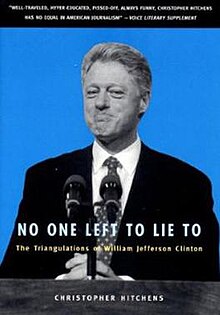No One Left to Lie To
 First edition cover (1999) | |
| Author | Christopher Hitchens |
|---|---|
| Country | United States/United Kingdom |
| Language | English |
| Subject | Bill Clinton |
| Publisher | Verso Books |
Publication date | 1999 |
| Media type | Print (hardcover and paperback) |
| Pages | 122 (original hardback) [1][2] 160 (expanded paperback) [3] |
| ISBN | 978-1859847367 |
| 973.929/092 | |
| LC Class | E886.2 .H58 1999 |
No One Left to Lie To: The Triangulations of William Jefferson Clinton is a 1999 book about Bill Clinton by author and journalist Christopher Hitchens. It was first published in hardback by the New Left Books imprint, Verso Books.[4]
Paperback edition[]
Its first publication in paperback in 2000 featured expanded content, a new subtitle (No One Left to Lie To: The Values of the Worst Family) and also the addition to the front cover of the image of Hillary Clinton.[5]
Synopsis[]
Journalist and essayist Christopher Hitchens's polemic on the political career of American president Bill Clinton. Hitchens examines Clinton's psychology and how it affected the then-president's record in war, acts that led to accusations of sexual abuse, his skill at "triangulation" and the relationship between Clinton and his wife Hillary.
Reception[]
No One Left to Lie To drew both favorable and critical responses. Referring to the work as "at once illuminating and depressing", Stephen Thompson of The A.V. Club wrote that Hitchens "ultimately does an excellent and revelatory job of not only breaking down Clinton's various alleged and provable offenses [...] but tying them together, making a case for how his much-discussed character flaws actually affect his ability to serve the people."[6] Nick Cohen of The Observer defended Hitchens's comparison of Clinton's America to a banana republic, and praised the section on the president's war crimes.[7]
Some critics were less positive. In the London Review of Books, Martin Jay criticized the lack of footnotes and argued that "the book is itself an extended op-ed piece, resting more on avid belief and strongly held opinions than hard, dispassionately presented knowledge, and liberally drawing on its author's formidable rhetorical skills to convince the reader. Hitchens's argument is based on a welter of assertions about Clinton's actions – many of which, I hasten to add, are all too plausible – that are never backed up in a convincing way by verifiable sources".[8] Charles Taylor of Salon accused Hitchens of making unsubstantiated accusations and wrote that "the damnable thing about 'No One Left to Lie To' is that had Hitchens focused on [Clinton's triangulations], he might have produced a very compelling and very damaging book."[9] Karen Lehrman of The New York Times, while lauding "Hitchens's brave willingness to show all the sordid scenarios in which our emperor has removed his clothes", found the book emotionally undisciplined in the depth of its negativity toward Clinton, writing that the author "is appalled by virtually everything the President does."[2]
References[]
- ^ "WebVoyage Record View 1". loc.gov.
- ^ a b Lehrman, Karen (May 9, 1999). "10,000 Things I Hate About You". The New York Times. Retrieved March 4, 2017.
- ^ Amazon publication data
- ^ "WebVoyage Record View 3". loc.gov.
- ^ Publisher's cover image
- ^ Thompson, Stephen (March 29, 2002). "Christopher Hitchens: No One Left To Lie To: The Triangulations Of William Jefferson Clinton". The Onion, Inc. Retrieved March 4, 2017.
- ^ Cohen, Nick (May 8, 1999). "And his pants are on fire". The Observer. Retrieved March 4, 2017.
- ^ Jay, Martin (July 29, 1999). "Mendacious Flowers". 21 (15): 16–17. Retrieved March 4, 2017. Cite journal requires
|journal=(help) - ^ Taylor, Charles (June 7, 1999). "The (un)friendly witness of Christopher Hitchens". Salon.com. Retrieved March 4, 2017.
- 1999 non-fiction books
- American biographies
- Biographies about politicians
- Books about Bill Clinton
- Books by Christopher Hitchens
- Verso Books books
- American politician book stubs